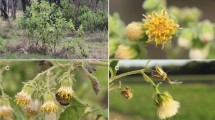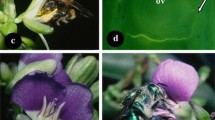Abstract
This study aims to understand the role of floral traits in determining the pollination and reproduction of Desmodium grahamii (Fabaceae, Papilionoideae) with explosive floral mechanism in populations occurring in a natural reserve and botanical garden in southern Mexico City. We assessed the breeding system by quantifying floral and pollinator activity, compatibility, pollination, and reproductive success, assisted by field and laboratory analyses. Results showed that cross-pollination and self-pollination coexist, but bees are required for fruit and seed set. Flower colour is the primary attractant. Floral scent is also likely important because the petals were covered with papillae, although no scent was perceptible. Morphological and functional observations of D. grahamii exhibit simultaneous pollen release and stigma receptivity when the flower is activated by a pollinator and there is no secondary pollen presentation; this contrasts with what has been reported on other species of Desmodium. Pollen is the pollinators’ only reward, and its deposition and collection must be done synchronically, occurring when a bee lands and introduces its proboscis in the flower. In this study, we identified seven floral visitors: five bee pollinators and two syrphid flies as pollen thieves. On some occasions, Apis mellifera also behaves as a pollen thief. Fruit and seed set of flowers that were isolated from visitors may indicate a delayed pollination mechanism. Pollination results also suggest that Apis bees and syrphid flies may contribute to fruit and seed production when they forage on flowers at post-anthesis.





Similar content being viewed by others
References
Agostini K, Sazima M, Sazima I (2006) Bird pollination of explosive flowers while foraging for nectar and caterpillars. Biotropica 38:674–678. https://doi.org/10.1111/j.1744-7429.2006.00191.x
Alemán M, Figueroa-Fleming Etcheverry A, Sühring S, Ortega-Baes P (2014) Explosive pollination mechanism in Papilionoideae (Leguminosae): an analysis with three Desmodium species. Pl Syst Evol 300:177–186. https://doi.org/10.1007/s00606-013-0869-8
Aluri R, Reddi C (1995) Explosive pollen release and pollination in flowering plants. Proc Indian Natl Sci Acad B61(4):323–332
Amaral-Neto L, Westerkamp C, Melo G (2015) From keel to inverted keel flowers: functional morphology of “upside down” papilionoid flowers and the behavior of their bee visitors. Pl Syst Evol 301:2161–2178. https://doi.org/10.1007/s00606-015-1221-2
Arroyo MT (1981) Breeding systems and pollination biology in Leguminosae. In: Polhill R, Raven P (eds) Advances in legume systematics. Part 2. Royal Botanic Gardens, Kew, pp 723–770
Austin DF (2004) Florida ethnobotany. CRC Press, Boca Raton
Brantjes N, De Vos O (1981) The explosive release of pollen in flowers of Hyptis (Lamiaceae). New Phytol 87:425–430. https://doi.org/10.1111/j.1469-8137.1981.tb03213.x
Cane J, Gardner D, Harrison P (2011) Nectar and pollen sugars constituting larval provisions of the alfalfa leaf-cutting bee (Megachile rotundata) (Hymenoptera: Apiformes: Megachilidae). Apidologie 42:401–408. https://doi.org/10.1007/s13592-011-0005-0
Castillo S, Martínez Y, Romero M, Guadarrama P, Núñez O, Sánchez I, Meave J (2007) La reserva ecológica del Pedregal de San Ángel. Aspectos florísticos y ecológicos. Universidad Nacional Autónoma de México, México
Chow KH, Crowder LV (1973) Hybridization of Desmodium species. Euphytica 22:399–404. https://doi.org/10.1007/BF00022653
Córdoba SA, Cocucci AA (2011) Flower power: its association with bee power and floral functional morphology in papilionate legumes. Ann Bot (Oxford) 108:919–931. https://doi.org/10.1093/aob/mcr196
Dobson H, Groth I, Bergstrom G (1996) Pollen advertisement: chemical contrast between whole-flower and pollen odors. Amer J Bot 83:877–885. https://doi.org/10.2307/2446264
Dukas R, Real LA (1991) Learning foraging tasks by bees: a comparison between social and solitary species. Anim Behav 42:269–276. https://doi.org/10.1016/S0003-3472(05)80558-5
Etcheverry A, Alemán M, Figueroa-Fleming T, López-Sphar D, Gómez C, Yáñez C, Figueroa-Castro D, Ortega-Baes P (2012) Pollen:ovule ratio and its relationship with other floral traits in Papilionoideae (Leguminosae): an evaluation with Argentine species. Pl Biol 14:171–178. https://doi.org/10.1111/j.1438-8677.2011.00489.x
Figueroa-Fleming T, Etcheverry A (2017) Comparing the efficiency of pollination mechanism in Papilionoideae. Arthropod Pl Interact 11:273–283. https://doi.org/10.1007/s11829-017-9515-7
Galloni M, Cristofolini G (2003) Floral rewards and pollination in Cytiseae (Fabaceae). Pl Syst Evol 238:127–137. https://doi.org/10.1007/s00600-002-0270-5
Gerling D, Velthuis H, Hefetz A (1989) Bionomics of the large carpenter bees of the genus Xylocopa. Annual Rev Entomol 34:163–190. https://doi.org/10.1146/annurev.en.34.010189.001115
Giurfa M, Sandoz J (2012) Invertebrate learning and memory: fifty years of olfactory conditioning of the proboscis extension response in honeybees. Learning Memory 19:54–66. https://doi.org/10.1101/lm.024711.111
Harley R (1971) An explosive pollination mechanism in Eriope crassipes, a Brazilian Labiate. Biol J Linn Soc 3:159–164. https://doi.org/10.1111/j.1095-8312.1971.tb00175.x
Hutton EM (1960) Flowering and pollination in Indigofera spicata, Phaseolus lathyroides, Desmodium uncinatum and some other tropical pasture legumes. Empire J Exp Agric 28:235–243
Kurian A, Asha M (2007) Medicinal plants. New India Publishing, New Delhi
León J (1968) Fundamentos botánicos de los cultivos tropicales. IICA, La Molina
Marinho C, Souza C, Barros T, Teixeira S (2014) Scent glands in legume flowers. Pl Biol 16:215–226. https://doi.org/10.1111/plb.12000
Ohashi H, Ohashi K (2018) Grona, a genus separated from Desmodium (Leguminosae Tribe Desmodieae). J Jap Bot 93:104–120
Ohashi K, Ohashi H, Nemoto T, Ikeda T, Izumi H, Kobayashi H, Muragaki H, Nata K, Sato N, Suzuki M (2018) Phylogenetic analyses for a new classification of the Desmodium Group of Leguminosae Tribe Desmodieae. J Jap Bot 93:165–189
Pradeepa S, Belavadi V (2018) Floral preferences for pollen by leaf cutter bees (Hymenoptera: Megachilidae) in Bangalore, India. J Entomol Zool Stud 6:588–596
Roberson A, Mountjoy C, Faulkner B, Roberts M, Macnair M (1999) Bumble bee selection of Mimulus guttatus flowers: the effects of pollen quality and reward depletion. Ecology 80:2594–2606. https://doi.org/10.1890/0012-9658(1999)080%5b2594:BBSOMG%5d2.0.CO;2
Roulston T, Cane J (2000) Pollen nutritional content and digestibility for animals. Pl Syst Evol 222:87–209. https://doi.org/10.1007/BF00984102
Royal Horticultural Society (1966) R.H.S. colour chart. Royal Horticultural Society, London
Sinu P, Bronstein J (2018) Foraging preferences of leafcutter bees in three contrasting geographical zones. Diversity Distrib 24:621–628. https://doi.org/10.1111/ddi.12709
Solomón R, Purnachandra S (2006) Nesting habits, floral resources and foraging ecology of large carpenter bees (Xylocopa latipes and Xylocopa pubescens) in India. Curr Sci 90:1210–1217
Stanley E, Otieno M, Steijven K, Piironen T, Willmer P, Nuttman C (2016) Pollination ecology of Desmodium setigerum (Fabaceae) in Uganda; do big bees do it better? J Poll Ecol 19:43–49. https://doi.org/10.26786/1920-7603(2016)1
Stout JC (2000) Does size matter? Bumblebee behaviour and the pollination of Cytisus scoparius L. (Fabaceae). Apidologie 31:129–139. https://doi.org/10.1051/apido:200011
Strelin MM, Aizen MA (2018) The interplay between ovule number, pollination and resources as determinants of seed set in a modular plant. Peer J 6:e5384. https://doi.org/10.7717/peerj.5384
Torres-Colín L, Delgado-Salinas A (2008) Flora del Valle de Tehuacán-Cuicatlán. Fasc. 59. Fabaceae Tribu Desmodieae. Instituto de Biología, Universidad Nacional Autónoma de México, México
Willmer P (2011) Pollination and floral ecology. Princeton University Press, Princeton
Willmer P, Stanley DA, Steivjven K, Mathews I, Nuttman C (2009) Bidirectional flower color and shape changes allow a second opportunity for pollination. Curr Biol 19:919–923. https://doi.org/10.1016/j.cub.2009.03.070
Yeo PF (1993) Secondary pollen presentation. Form, function and evolution. Pl Syst Evol Suppl 6:1–268
Acknowledgements
This work was supported by Consejo Nacional de Ciencia y Tecnología (CONACyT) and is the result of the AM-P undergraduate thesis in the Facultad de Ciencias-Biología, Universidad Nacional Autónoma de México (UNAM). We would like to thank all the help given by researchers that allowed this work to be achieved, especially to Ricardo Wong for his assistance in the video recording and photography of the bees; to Berenit Mendoza Garfias for the MEB microphotographs; to Alfredo Wong who assisted with UV photography, and Ismael A. Hinojosa-Díaz, Curator of the Bee Section (Hymenoptera: Apoidea), Colección Nacional de Insectos (CNIN), for his guidance on bee identification. The support of the Secretaría Ejecutiva de la Reserva Ecológica del Pedregal de San Ángel (REPSA, UNAM) and staff of the Botanical Garden (IBUNAM) is greatly acknowledged. We thank two anonymous reviewers for their help and suggestions.
Author information
Authors and Affiliations
Corresponding author
Additional information
Handling Editor: Louis P. Ronse De Craene.
Publisher's Note
Springer Nature remains neutral with regard to jurisdictional claims in published maps and institutional affiliations.
Electronic supplementary material
Below is the link to the electronic supplementary material.
Supplementary material 1 (MOV 35674 kb)
Information on Electronic Supplementary Materials
Information on Electronic Supplementary Materials
Online Resource 1. Desmodium grahamii pollination by Xylocopa tabaniformis azteca.
Rights and permissions
About this article
Cite this article
Miguel-Peñaloza, A., Delgado-Salinas, A. & Jiménez-Durán, K. Pollination biology and breeding system of Desmodium grahamii (Fabaceae, Papilionoideae): functional aspects of flowers and bees. Plant Syst Evol 305, 743–754 (2019). https://doi.org/10.1007/s00606-019-01603-4
Received:
Accepted:
Published:
Issue Date:
DOI: https://doi.org/10.1007/s00606-019-01603-4




